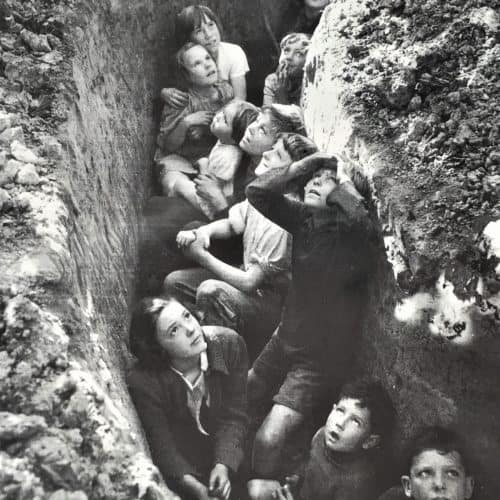WW2 13: Battle of Britain
This is a tiny metal lapel badge, less than 3cm across. It was on sale during World War 2 and the money raised helped buy more Spitfire fighter aeroplanes for the RAF (Royal Air Force).
More Spitfires were always needed. Folkestone, like several other towns in Kent, collected enough money to buy its own Spitfire.
Spitfires and Hurricanes were British fighter aircraft flown by pilots in the RAF during World War 2. Pilots came from the UK, and lots of other countries around the world, including Poland, Czechoslovakia, France, Canada, Australia, New Zealand, South Africa and the West Indies.
The pilots who flew them helped save Britain from German invasion during what was called The Battle of Britain in the summer of 1940.
They shot down hundreds of German bombers that were attacking airfields and other important military sites in Kent.
These are Spitfire pilots with one of the Spitfires bought by the people in Kent.
Look closely and you can see the Invicta white horse (symbol of the county of Kent) painted on the fuselage, and the name of the plane: Spirit of Kent.
Image copyright: Battle of Britain Museum, Hawkinge
Here are two Spitfires flying over Kent in World War 2
These children are sheltering in a trench ‘somewhere in Kent’, watching the Battle of Britain taking place in the sky above.
Being in the trench will protect them from blast from falling bombs, so long as it’s not a direct hit.
What do you think the children are thinking?
The Battle of Britain could clearly be seen the skies above Folkestone, and people in the town often watched dogfights between British and German aircraft.
RAF fighter aircraft flew from several airfields in Kent. The nearest one to Folkestone was at Hawkinge.
Parts of this airfield survives today and there’s an excellent Battle of Britain Museum.
Image copyright: Kent Messenger Group
This is a page from a cartoon book given to trainee RAF pilots in World War 2. It was called Forget-Me-Nots for Fighters. The cartoons highlight important things pilots should do to stay alive in combat.
One of these was ‘never stop looking round’ every few seconds for enemy planes, which could attack from any direction. A favourite tactic was to attack ‘out of the sun’ which was very difficult to spot.
If a pilot stopped looking round, he could easily be shot down by the enemy. This is highlighted in the bottom cartoon, where the Spitfire pilot, too busy reading his map, doesn’t see the attacking German (who would be in his plane, rather than crawling over the fuselage!).
It’s a page from a World War 2 aircraft recognition book.
It shows the silhouettes of a Junkers 88 and a Heinkel 111. These two types of German bombers that attacked Britain and dropped bombs on Folkestone.
During the war, people had to learn to recognise the different types of British and German aircraft. This was important for pilots, aircraft spotters, anti-aircraft gunners, Air Raid Wardens and many others.
If they could recognise the planes, they could report the type, location and number of enemy planes so RAF fighters could be scrambled (take off to intercept the enemy as quickly as possible).
It also helped prevent RAF pilots shooting down their own planes by mistake.
This Approach to Aircraft Recognition book contains the silhouettes and other important characteristics of 64 British and enemy aircraft.







